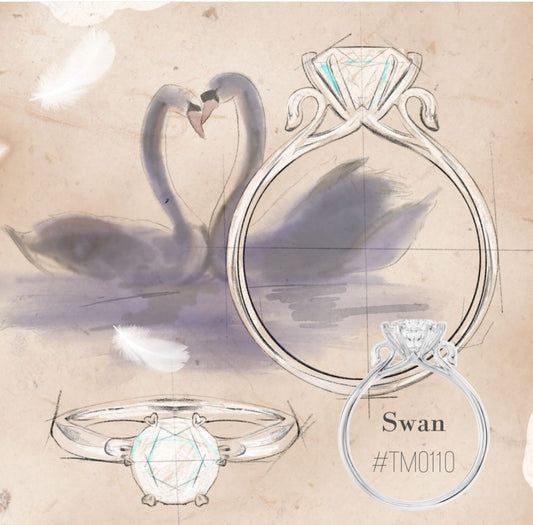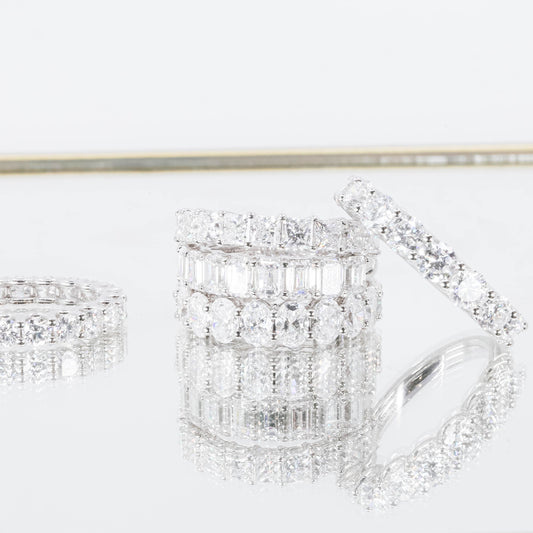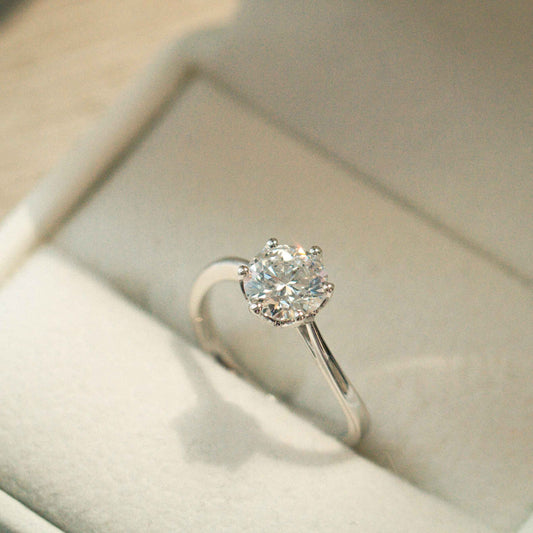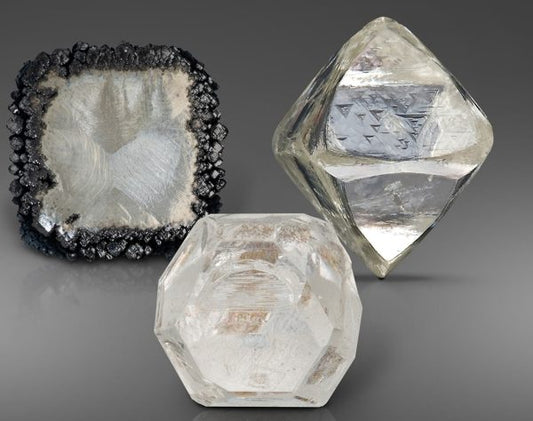When choosing a diamond ring, in addition to considering its style, the material of the ring is also very important. The color and characteristics of the metal directly affect the appearance and safety. Among them, the most well-known and popular materials are platinum (PT) and 18K gold. The following will introduce to you the characteristics of the two materials:
1. Platinum
Platinum is an extremely precious metal, the English abbreviation is PT, commonly known as pure platinum and platinum. Because of its very high density and purity, its particles are closely arranged, and it is rarer than gold, so it is often used as a material for wedding rings. There are not many origins of platinum, mainly Russia and South Africa.
Color: natural silvery white
General marking specifications:
Platinum 950: refers to jewelry containing 950 parts per thousand of pure platinum, of which 5% is alloy. It is mostly used as inlaid jewelry and is engraved with "Pt950";
Platinum 900: refers to jewelry containing 900 parts per thousand of pure platinum, of which 10% is alloy. It is mostly used as inlaid jewelry and is engraved with "Pt900";
Advantages: The output is rare and very precious;
Platinum is extremely pure and non-allergenic, suitable for people with sensitive skin; it is not easy to fade.
Disadvantages: The texture is relatively soft and easily damaged; the price is more expensive than 18K gold.
2. 18K Gold
18K gold, also known as AU750, AU is the chemical symbol of the metal, and the K in 18K gold comes from "KARAT", which is used to measure the purity of gold. 18K gold refers to a gold content of up to 75%, mixed with 25% of other metals, including silver, palladium, platinum, nickel, etc.
Color: Mixing different metals and electroplating will cause K gold to appear in different colors, including 18K white gold (silver white), 18K gold and 18 rose gold.
18K white gold is the most common and popular, 18K gold is better paired with yellow diamonds, and 18K rose gold is better paired with pink diamonds or low-color diamonds.
Advantages: high hardness, relatively wear-resistant and safe, not easily damaged
Disadvantages: Light weight; will fade if worn for a long time.
3. Comparison between platinum and 18K gold
Which one is better, platinum or 18K gold? Although both have their own merits in different aspects, if the diamond value is larger, such as an engagement ring, we generally recommend 18K gold for the following reasons:
- security
The higher the purity of platinum, the softer it is, so 18K gold inlaid with diamonds is stronger.
- Durability
Compared with platinum, 18K gold is more durable and durable. Although scratches on 18K gold will reduce the volume of gold, from an aesthetic point of view, the scratches left by platinum are more conspicuous than 18K gold, and are even visible flaws to the naked eye. Therefore, the hardness and wear resistance of 18K gold Better and less prone to wear and tear.
- Variety of styles
Since the output of platinum is less than that of 18K gold, and its hardness is also lower than that of 18K gold, it is not suitable for inlaying luxurious styles. However, 18k gold has good flexibility, high strength, and low melting point, so it is easier to shape and shape, and is adaptable to craftsmanship. Stronger. In addition, the color of platinum is single, while the color of 18K gold is more variable. Therefore, in terms of inlay angle, 18K has greater plasticity and the styles that can be produced are more varied.
Under what circumstances should you choose platinum?
It can be roughly considered from two aspects:
1. Wedding ring
As mentioned above, platinum will not fade and symbolizes the purity and eternity of love. It is particularly meaningful when purchasing wedding rings. There is less need to worry about the safety of diamonds for wedding rings, so platinum is more suitable.
2. Skin allergies to metals
Platinum is very suitable for people with skin allergies to wear, and it is effectively anti-allergic. As for 18K gold, although it is not as hypoallergenic as platinum, it is still much better than the silver/copper jewelry in the market.
4. Which setting method is suitable for platinum and 18K gold on a diamond ring?
Generally speaking, prong setting is the most common classic setting method, and prong setting can be divided into four-prong diamond rings and six-prong diamond rings:
four prong inlay
There are two inlay methods:
 .
.
The traditional straight four prongs are four metal prongs inlaid on the diamond, which are inlaid in the directions of 2, 4, 8, and 10 on the clock. In terms of visual effect, it is close to a square image;
 .
.
Cross prongs are four metal prongs inlaid on a diamond, set in the four directions of east, south, west and north. They are more commonly used in the design of square diamonds. Visually, they have the effect of magnifying the diamond and are suitable for Clients who want to highlight the central diamond.
Advantages of four prongs: visually simpler, effectively highlighting diamonds.
Disadvantages of four-claws: Compared with six-claws, they are less stable and less safe;
Six prong inlay

.
Suitable diamonds: Large diamonds (larger than one carat), the six-prong setting design effectively sets the diamond more firmly and safely.
The advantages of six-claw: the most classic and attractive inlay method, high firmness;
Disadvantages of six claws: due to the large number of claws
Generally speaking, considering safety factors, if you want to choose platinum, it is best to choose six-claws; while 18K gold is already very safe. The decision between four-claws or six-claws depends on the customer's personal preference and wearing effect.
 +852 66299915
+852 66299915





